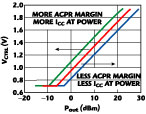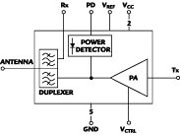Wireless communications handsets are increasing in functionality through the addition of features such as GPS, color displays and PDA functions. At the same time the handset is maintaining a roughly constant price and size target. Because of this trend, handset manufacturers are requiring higher levels of integration from component suppliers to increase the functionality, reduce the cost and reduce the parts count in the bill of materials. To satisfy this market requirement, TriQuint Semiconductor, along with its CDMA345™ partner, Atmel Corporation, has developed a fully integrated cellular band CDMA front-end module that integrates the functionality of the power amplifier module, power detector and coupler, isolator and duplexer into a single 6.0 x 11.5 mm monolithic module. The module is optimized to meet all of the IS-95 and IS-98 system specifications of the front-end over bias, frequency and temperature. In addition, the power amplifier includes an analog continuous bias in order to minimize current consumption at all output powers, thus maximizing the handset talk time.
Figure 1 shows the basic architecture of the TQM71312 cellular band power amplifier/duplexer (PAD) module. The module includes a power amplifier, which is a second generation of TriQuint's SiGe-based CDMA power amplifiers, utilizing Atmel's SiGe technology for CDMA and a surface acoustic wave (SAW) duplexer, that is a second generation of Sawtek's CDMA SAW-based duplexers. The module is constructed using TriQuint's power amplifier module manufacturing platform. The power amplifier die includes an integrated power detector, which is designed to provide an accurate determination of the module output power even under extreme mismatch conditions. In addition, the die includes an analog continuous bias that allows the user to optimize the current consumption of the power amplifier at all output powers using an analog control voltage from the baseband chip, as shown in Figure 2 .

By shifting the Vctrl curve to the left, the customer can obtain more adjacent channel power ratio (ACPR) margin at higher Icc; by shifting the curve to the right, the user can obtain a lower current consumption with less ACPR margin. The continuous bias circuit is temperature compensated in order to use a single control curve over all temperature conditions.
Figure 3 shows the measured CDMA gain, current consumption and ACPR of the TQM71312 module as referenced to the output power of the duplexer. As can be seen, the ACPR of the part is better than 50 dBc over all output powers. Additionally, the current consumption of the part is very low due to the continuous bias circuit. The quiescent current (Icq) of the amplifier is only 30 mA. By using the CDG probability distributions for the CDMA signal, the average current consumption of the PA duplexer can be determined for both urban and suburban environments. The average current consumption for the TQM71312 is 44 mA for urban environments and 61 mA for suburban environments, which represents an approximate 40 percent improvement over a typical one-bit 4 mm PA module. The analog continuous bias also provides a continuous gain reduction of approximately 10 dB at low power, which improves the dynamic range of the automatic gain control in the transmit chain.

The TQM71312 module is the first of a family of highly integrated CDMA front-ends. Additional models for USPCS, UMTS and KPCS will soon be available. All of the PAD (PA + Duplexer) family will have integrated continuous bias, integrated power detection and integrated isolator functionality, and will be fully optimized over all temperature, bias and power levels. The PAD family offers the performance, integration, size and ease of use needed by today's phone designers. Additional information may be obtained from John Canfield, director, product marketing, handsets, at jpc@sawtek.com.
TriQuint Semiconductor Inc.,
Hillsboro, OR (407) 886-7061,
www.triquint.com.
Circle No. 304

